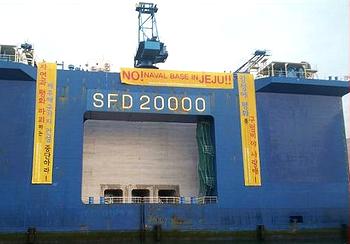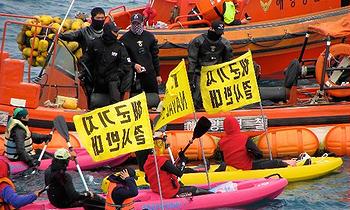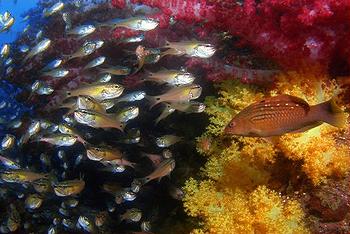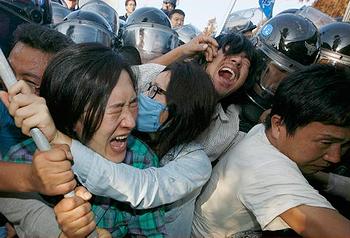JEJU ISLAND, South Korea,
September 6, 2012 (ENS) – The International Union for the Conservation
of Nature, IUCN, the world’s oldest environmental group, opened its
World Conservation Congress to some 8,000 attendees on Jeju Island
Wednesday, throwing into the spotlight a bitter battle over a naval base
being built on the island.
Plans for the military base near the village of Gangjeong, which the Korean government refers to as a military-civilian tourism port, were confirmed by the government in February and construction began in March. The site is just one kilometer from a UNESCO World Heritage Site on the environmentally spectacular volcanic island.
Today, five anti-base activists climbed a massive concrete caisson in Hwasoon Port, about 40 minutes by car from Gangjeong village, and hung protest banners. The Samsung corporation is making the caissons there and shipping them to Gangjeong to build the piers of the naval base.
 The
protest action began around dawn, as the protestors scaled the caisson
and displayed three large banners, two in Korean, one in English which
said, “No! Naval Base in Jeju!”
The
protest action began around dawn, as the protestors scaled the caisson
and displayed three large banners, two in Korean, one in English which
said, “No! Naval Base in Jeju!”
At 7:30 am, construction workers assaulted the occupiers and began destroying the banners. An hour later, police began arresting the protestors, two of whom had chained themselves to the caisson. By 9 am all five were arrested and now are in police custody. Two are complaining of back pain as a result of the workers’ assault. The charges appear to be “group trespass of a facility.”
The demonstrators released a statement saying, “Given that it is clear that the Jeju Naval base to be built in Gangjeong Village will be a military outpost of the United States, we cannot stand for our Gangjeong village, our Jeju Island to be in the middle of a conflict between an expanding China and the United States containment efforts. We know that the destruction of Gangjeong Village and Jeju, the Peace Island, will become the suffering of all our people.”
“Because of the recent typhoons, all seven caisson [brought so far to Gangjeong], the symbol of the Jeju naval base construction, were completely broken to pieces and left under the Gangjeong Sea. Still the Navy and [construction companies] Samsung and Daelim continue to eagerly produce new caisson in Hwasoon Port,” the demonstrators said.
“Many villagers, religious figures, and peace activists have been injured, arrested, and imprisoned to stop this naval base construction in the village,” they said. “Even though our power might be small, we will fight with all our strength against this enormous dominating power, symbolized by this caisson.”
Villagers and activists struggle daily against the base. Catholic Mass, Protestant prayer services, individual and group protests, dancing, singing, police violence and state oppression are all things that can be seen every day in Gangjeong. Most protests happen in front of the two gates to the construction site.
These demonstrators and hundreds more who have attempted for years to block the naval base say war has no place on their island of peace, and protest against the “ongoing destruction of paradise.”
Jeju Island has what the World Heritage Committee describes as “the finest lava tube system of caves anywhere, with its multicoloured carbonate roofs and floors, and dark-coloured lava walls.” Also protected as part of the World Heritage Site is “the fortress-like Seongsan Ilchulbong tuff cone, rising out of the ocean, a dramatic landscape; and Mount Halla, the highest in Korea, with its waterfalls, multi-shaped rock formations, and lake-filled crater.”
“The site, of outstanding aesthetic beauty, also bears testimony to the history of the planet, its features and processes,” said the World Heritage Committee of the site it protected in 2007 at the request of the South Korean government.
The protest movement, under the name Emergency Action to Save Jeju Island, sent an Open Letter to the IUCN on August 27, objecting to the IUCN’s denial of Gangjeong villagers’ application for a booth within the World Conservation Congress.
In a response to the Open Letter on August 28, IUCN Director-General Julia Marton-Lefevre said, “IUCN has consistently supported the application of the Gangjeong Village Committee to have an exhibition stand at the Congress. Unfortunately our recommendation was not endorsed by our on-site partners.”
The group’s global communications director, John Kidd, told ENS in an email, “We have consistently supported their application. We would very much like to see them participating fully in the Forum part of the Congress (the other part being the Assembly of our member organizations). We would also like to see Congress delegates (thousands of conservationists from around the world) learn more about the naval base project.”
 But one
signer of the Open Letter, Bruce Gagnon, said Wednesday, “So far the WCC
leadership, with funding coming from Samsung and the South Korea
government, have refused to allow the Gangjeong village to have a
display booth inside the convention.”
But one
signer of the Open Letter, Bruce Gagnon, said Wednesday, “So far the WCC
leadership, with funding coming from Samsung and the South Korea
government, have refused to allow the Gangjeong village to have a
display booth inside the convention.”
“In addition,” said Gagnon, coordinator of the Maine-based nonprofit Global Network Against Weapons and Nuclear Power in Space, “attempts to have the village leaders speak at the event have been suppressed by the government.”
But the naval base opponents will not be silenced. There are plans to introduce an emergency motion concerning the environmental impact of the Navy base on the WCC floor during the plenary session.
Gangjeong village Mayor Kang Dong-kyun intends to hand-deliver a petition to Marton-Lefevre at the Congress requesting that the IUCN support the passage of an IUCN Assembly Resolution calling on the South Korean government to shut down plans for the new base.
The petition also asks Marton-Lefevre to let the Gangjeong people speak by giving them the information booth at the conference that was promised to them and tell the Korean government that the villagers have a right to protest at the Convention.
Finally, the petition asks her to visit Gangjeong village to see the destruction that the naval base is already causing.
The Open Letter, signed by many prominent environmentalists from around the world, says, “The once-celebrated southern Jeju coastline is now being covered in concrete, thanks to the Korean government, Samsung corporation, and the silence of IUCN.”
“The naval base project, meant to become home-port for Korean and U.S. missile-carrying warships 300 miles from China, is threatening one of the planet’s last great soft coral reefs, and other coastal treasures, killing numerous endangered species (including one on IUCN’s famous Red List), and destroying centuries-old sustainable communities of local farmers and fishers,” says the Open Letter.
“The Gangjeong villagers have been protesting the base project for years, and are being met with daily police brutality,” the Open Letter says. “Such activities represent all that IUCN has traditionally opposed.”
The IUCN still does oppose police brutality. Replying to an ENS question, Kidd said, “No! IUCN does not condone police brutality. Various open letters, including this one, attribute things to IUCN that are not true. Another example is that IUCN ‘supports’ or ‘praises’ the naval base project. This is not true, and we have never said this.”
“Members of the Village Committee, and indeed anyone interested in any conservation issue from the Republic of Korea or elsewhere, are welcome to register and attend the Forum events of our Congress, to share information and join in constructive debate,” said Kidd.
“I understand that there will be several events at the Congress where the concerns regarding the Jeju naval base project may be debated,” he said, “and that interested delegates might visit Gangjeong, see the site, and participate in one of the events being organized there by the Village Committee.”
 Environment News Service (http://s.tt/1mCed)
Environment News Service (http://s.tt/1mCed)
Plans for the military base near the village of Gangjeong, which the Korean government refers to as a military-civilian tourism port, were confirmed by the government in February and construction began in March. The site is just one kilometer from a UNESCO World Heritage Site on the environmentally spectacular volcanic island.
Today, five anti-base activists climbed a massive concrete caisson in Hwasoon Port, about 40 minutes by car from Gangjeong village, and hung protest banners. The Samsung corporation is making the caissons there and shipping them to Gangjeong to build the piers of the naval base.

Jeju Island naval base protesters hang banners from a caisson, September 6, 2012 (Photo courtesy Save Jeju Now)
At 7:30 am, construction workers assaulted the occupiers and began destroying the banners. An hour later, police began arresting the protestors, two of whom had chained themselves to the caisson. By 9 am all five were arrested and now are in police custody. Two are complaining of back pain as a result of the workers’ assault. The charges appear to be “group trespass of a facility.”
The demonstrators released a statement saying, “Given that it is clear that the Jeju Naval base to be built in Gangjeong Village will be a military outpost of the United States, we cannot stand for our Gangjeong village, our Jeju Island to be in the middle of a conflict between an expanding China and the United States containment efforts. We know that the destruction of Gangjeong Village and Jeju, the Peace Island, will become the suffering of all our people.”
“Because of the recent typhoons, all seven caisson [brought so far to Gangjeong], the symbol of the Jeju naval base construction, were completely broken to pieces and left under the Gangjeong Sea. Still the Navy and [construction companies] Samsung and Daelim continue to eagerly produce new caisson in Hwasoon Port,” the demonstrators said.
“Many villagers, religious figures, and peace activists have been injured, arrested, and imprisoned to stop this naval base construction in the village,” they said. “Even though our power might be small, we will fight with all our strength against this enormous dominating power, symbolized by this caisson.”
Villagers and activists struggle daily against the base. Catholic Mass, Protestant prayer services, individual and group protests, dancing, singing, police violence and state oppression are all things that can be seen every day in Gangjeong. Most protests happen in front of the two gates to the construction site.
These demonstrators and hundreds more who have attempted for years to block the naval base say war has no place on their island of peace, and protest against the “ongoing destruction of paradise.”
Jeju Island has what the World Heritage Committee describes as “the finest lava tube system of caves anywhere, with its multicoloured carbonate roofs and floors, and dark-coloured lava walls.” Also protected as part of the World Heritage Site is “the fortress-like Seongsan Ilchulbong tuff cone, rising out of the ocean, a dramatic landscape; and Mount Halla, the highest in Korea, with its waterfalls, multi-shaped rock formations, and lake-filled crater.”
“The site, of outstanding aesthetic beauty, also bears testimony to the history of the planet, its features and processes,” said the World Heritage Committee of the site it protected in 2007 at the request of the South Korean government.
The protest movement, under the name Emergency Action to Save Jeju Island, sent an Open Letter to the IUCN on August 27, objecting to the IUCN’s denial of Gangjeong villagers’ application for a booth within the World Conservation Congress.
In a response to the Open Letter on August 28, IUCN Director-General Julia Marton-Lefevre said, “IUCN has consistently supported the application of the Gangjeong Village Committee to have an exhibition stand at the Congress. Unfortunately our recommendation was not endorsed by our on-site partners.”
The group’s global communications director, John Kidd, told ENS in an email, “We have consistently supported their application. We would very much like to see them participating fully in the Forum part of the Congress (the other part being the Assembly of our member organizations). We would also like to see Congress delegates (thousands of conservationists from around the world) learn more about the naval base project.”

Jeju islanders in kayaks face off with police in a protest against the naval base. (Photo courtesy Save Jeju Now)
“In addition,” said Gagnon, coordinator of the Maine-based nonprofit Global Network Against Weapons and Nuclear Power in Space, “attempts to have the village leaders speak at the event have been suppressed by the government.”
But the naval base opponents will not be silenced. There are plans to introduce an emergency motion concerning the environmental impact of the Navy base on the WCC floor during the plenary session.
Gangjeong village Mayor Kang Dong-kyun intends to hand-deliver a petition to Marton-Lefevre at the Congress requesting that the IUCN support the passage of an IUCN Assembly Resolution calling on the South Korean government to shut down plans for the new base.
The petition also asks Marton-Lefevre to let the Gangjeong people speak by giving them the information booth at the conference that was promised to them and tell the Korean government that the villagers have a right to protest at the Convention.
Finally, the petition asks her to visit Gangjeong village to see the destruction that the naval base is already causing.
The Open Letter, signed by many prominent environmentalists from around the world, says, “The once-celebrated southern Jeju coastline is now being covered in concrete, thanks to the Korean government, Samsung corporation, and the silence of IUCN.”
“The naval base project, meant to become home-port for Korean and U.S. missile-carrying warships 300 miles from China, is threatening one of the planet’s last great soft coral reefs, and other coastal treasures, killing numerous endangered species (including one on IUCN’s famous Red List), and destroying centuries-old sustainable communities of local farmers and fishers,” says the Open Letter.
“The Gangjeong villagers have been protesting the base project for years, and are being met with daily police brutality,” the Open Letter says. “Such activities represent all that IUCN has traditionally opposed.”
The IUCN still does oppose police brutality. Replying to an ENS question, Kidd said, “No! IUCN does not condone police brutality. Various open letters, including this one, attribute things to IUCN that are not true. Another example is that IUCN ‘supports’ or ‘praises’ the naval base project. This is not true, and we have never said this.”
“Members of the Village Committee, and indeed anyone interested in any conservation issue from the Republic of Korea or elsewhere, are welcome to register and attend the Forum events of our Congress, to share information and join in constructive debate,” said Kidd.
“I understand that there will be several events at the Congress where the concerns regarding the Jeju naval base project may be debated,” he said, “and that interested delegates might visit Gangjeong, see the site, and participate in one of the events being organized there by the Village Committee.”


No comments:
Post a Comment